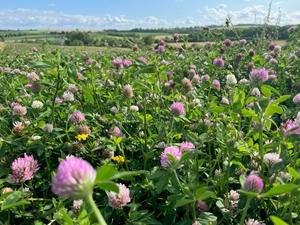By Alastair Leake, Director of Policy & Allerton Project
 There’s a row broken out in the Garden of Eden. Apparently, we must cease our assiduous nurturing of our horticultural havens and allow nature to do a Brexit and “take back control”. Yes, you’ve guessed, the Rewilders have your lawns in their sights!
There’s a row broken out in the Garden of Eden. Apparently, we must cease our assiduous nurturing of our horticultural havens and allow nature to do a Brexit and “take back control”. Yes, you’ve guessed, the Rewilders have your lawns in their sights!
Anyone would think this was a new concept given the excitement it is engendering. Not so. I recall pioneering this very concept 40 years ago in our student house. I grew a fine crop of hay, which of course, in true rewilding form, I did not harvest. It cost me my deposit.
Green-fingered legends Alan Titchmarsh and Monty Don have been quick to react to the rewilded garden concept, the latter branding it “puritanical nonsense”. As a Graduate of Horticultural Science myself, I feel inclined to agree. That old adage of “one year’s seeding, seven years of weeding” has a deal of truth in it, so if you wish to rewild your garden you’d be well advised not to change your mind!
The whole purpose of a garden is to display a range of different plants within a confined space. The plants are arranged to give contrast in structure and foliage colour, and flower in succession across the widest of seasons. A good garden will have been designed to do this, touched by the tender’s personal preferences. Such an approach delivers far more diversity than abandonment.
Those of us who have been farming for a few decades will remember when we were required to re-wild 15% of our cropped land each year under the Common Agriculture Policy of set-aside. The diversity that emerged reliably consisted of pernicious arable weeds, which were sprayed off with glyphosate on 15 May each year, which became known as ‘National Roundup Day’; 15% of the countryside turned brown. I’ve just come in from showing some visitors around the farm. We visited a set-aside field that has been sown with a mixture of legumes, which have grown to knee height and are now in full flower. You can smell the sweetness of the different types of clover, vetch, birdsfoot trefoil and chicory from 50 metres away: the hum of insects from 10. And all of this because Oliver, our farm manager, sowed it and mowed it.
At the side of the field, I can see some wildbird cover getting going. There’s a whole range of species that are going to produce different seeds to feed different birds at different times through next winter. These plants are not here by chance. They are here because, nearly 30 years ago, the Allerton Research team did a study of what birds eat what seeds and when. From that, they created a complex designer seed mix and a living bird table. Not even nature is that clever.
When it comes to the garden, certainly my tolerance of common pests has vastly increased. I’ve learned to watch the sparrows harvesting the greenfly from the lupin stems once there’s enough of them to make it a worthwhile supper. Inspired by the concept of the diversionary feeding of hen harriers on moorland, I find the same concept works for snails, preserving the lettuces whilst, in turn, providing nourishment to the thrushes that nest here in the clipped hedges, mostly thanks to the protection their nests receive from our gamekeeper.
So just as we have found on the farm, tending to plants in the garden is good for nature. I’ve yet to see the evidence that an abandoned garden has more to offer. So I’m with Monty and Alan on this one. Happy weeding.